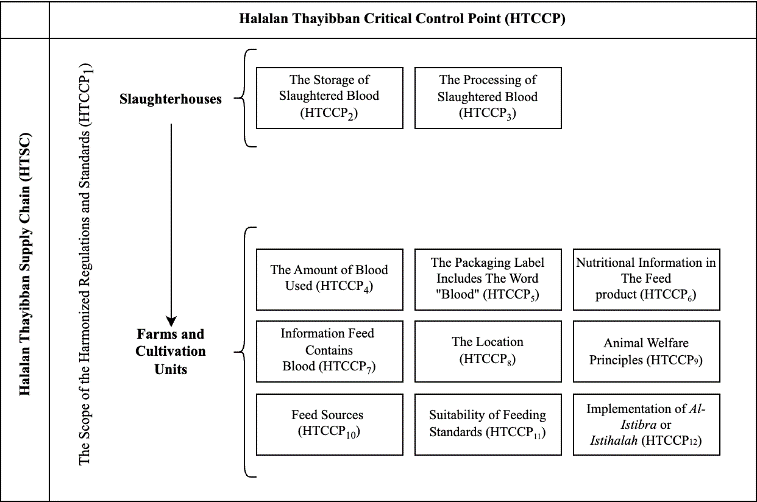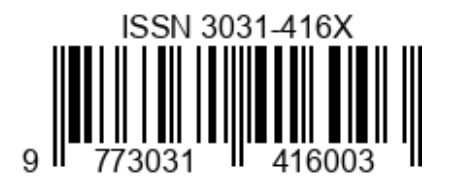The halalan thayyiban supply chain in handling blood products of slaughtering cattle, chicken, and pig for feeding and handling al-jallalah 1 (cattle, chicken, and catfish)
Abstract
Blood from the slaughter of cattle and chicken, is an economically valuable waste that can not be disposed into the environment. Its application in animal feed requires careful consideration of the composition and potential impact. The Indonesian Ulema Council issued a Fatwa regarding the Law on Livestock Animals Fed with Unclean Items. From a Sharia perspective, the feed composition is crucial, since it needs to be free from unclean ingredients to prevent animals from becoming classified as Al-Jallalah (Livestock Animals Fed with Unclean Items). To ensure compliance with the religious guidelines, it is necessary to implement a quarantine (Al-Istibra) or purification period (Istihalah). Therefore, this study aimed to analyze the halalan thayyiban supply chain in the management of blood from slaughtering ruminants (cattle), poultry (chicken), and pig for feed. Implementation of good practices in managing blood from slaughterhouses was assessed. The suitability of feed labels, including the presence of prohibited ingredients, adherence to good practices, and the application of Al-Istibra or Istihalah in cattle and chicken farms, as well as catfish farming units, was evaluated through questionnaire interviews and conformity scores. The results showed that 2 out of 7 (seven) objects received lower scores due to the limited effectiveness of the Waste Water Treatment Plants (WWTPs) and unclear regulations regarding the use of blood. Based on the suitability value of the feed label, 1 (one) out of 8 (eight) objects received a lower score for failing to meet technical requirements. The feed was contaminated, and there were no operational procedures for implementing Al-Istibra or Istihalah.
References
Bahrudin SSM, Illyas MI, MI Village. Tracking and tracing technology for halal product integrity over the supply chain. IEEE Symposium on Business, Engineering and Industrial Applications. 2011;1-7.
[BPS] Central Bureau of Statistics. Number of livestock slaughtered in RPH and outside RPH reported in 2019. BPS, Jakarta. 2020.
[BPS] Central Bureau of Statistics. Population of free-range chickens, broiler breeds, and laying breeds according to province in 2020. BPS, Jakarta. 2021.
[BSN] National Standardization Agency. SNI 01-4087:2006 concerning artificial feed for catfish (Clarias gariepinus). BSN, Jakarta. 2006.
[BSN] National Standardization Agency. SNI 01-6159:1999 concerning slaughterhouses. BSN, Jakarta. 1999a.
[BSN] National Standardization Agency. SNI 01-6160:1999 concerning poultry slaughterhouses. BSN, Jakarta. 1999b.
[BSN] National Standardization Agency. SNI 3148.2:2017 concerning concentrate feed - Part 2: Beef cattle. BSN, Jakarta. 2017.
[BSN] National Standardization Agency. SNI 8173.1:2015 concerning broiler flavored chicken feed - Part 1: Before the pre-starter period. BSN, Jakarta. 2015b.
[BSN] National Standardization Agency. SNI 8228.4:2015 concerning good fish cultivation methods (CBIB) Part 4: Freshwater fish. BSN, Jakarta. 2015a.
[BSN] National Standardization Agency. SNI 99002:2016 concerning halal slaughter of poultry. BSN, Jakarta. 2016.
[BSN] National Standardization Agency. SNI 99003:2018 concerning halal slaughter of ruminant animals. BSN, Jakarta. 2018.
Faruqi MUA. Authentication of the appropriateness of halal standards for catfish skin gelatin from quarantine periodization (istihalah) in cultivation with feed containing pork contaminants [thesis]. Bogor Agricultural Institute, Bogor. 2019.
Hehsan MR. QA Medical Fiqh. PTS, Selangor. 2015.
Jamaluddin MA, Ramli MA, Hashim DM. Fiqh istihalah: Integration of science and Islamic law. Revelation and Science. 2012;2(2):117-123.
Khawaja T, Khan SH, Ansari NN. Effect of different levels of blood meal on broiler performance during two phases of growth. International Journal of Poultry Science. 2007;6(12):860-865. https://doi.org/10.3923/ijps.2007.860.865
Kurniasih T. Potential of blood meal as an alternative source of protein for fish feed. 2011;1001-1008.
[Kementan] Ministry of Agriculture. Minister of Agriculture Regulation Number 11 of 2020 concerning certification of veterinary control numbers for animal product business units. Ministry of Agriculture, Jakarta. 2020.
[Kementan] Ministry of Agriculture. Minister of Agriculture Regulation Number 13/Permentan/OT.140/1/2010 concerning requirements for ruminant slaughterhouses and meat handling units. Ministry of Agriculture, Jakarta. 2010.
[Kementan] Ministry of Agriculture. Minister of Agriculture Regulation Number 65/Permentan/OT.140/9/2007 concerning guidelines for supervision of feed quality. Ministry of Agriculture, Jakarta. 2007.
[Kementan] Ministry of Agriculture. Minister of Agriculture Regulation no. 22/Permentan/PK.110/6/2017 concerning registration and distribution of feed. Ministry of Agriculture, Jakarta. 2017.
[Kementan] Ministry of Agriculture. Regulation of the Minister of Agriculture Number 482/Kpts/PD.620/8/2006 concerning types of ruminants and their products which are at risk of carrying BSE disease agents whose importation into the territory of the Republic of Indonesia is prohibited. Ministry of Agriculture, Jakarta. 2006.
[Kementan] Ministry of Agriculture. Decree of the Minister of Agriculture Number 471/Kpts/TN.530/7/2002 concerning prohibition of the use of meat meal, bone meal, blood meal, meat and bone meal (TDT) and other ingredients of ruminant origin as ruminant animal feed. Ministry of Agriculture, Jakarta. 2002.
[KepKKP] Ministry of Maritime Affairs and Fisheries. Decree of the Minister of Maritime Affairs and Fisheries of the Republic of Indonesia Number Kep.02/MEN/2007 concerning good fish cultivation methods. Ministry of Maritime Affairs and Fisheries, Jakarta. 2007.
[KepKKP] Ministry of Maritime Affairs and Fisheries. Regulation of the Minister of Maritime Affairs and Fisheries of the Republic of Indonesia Number 55/PERMEN-KP/2018 concerning fish feed. Ministry of Maritime Affairs and Fisheries, Jakarta. 2018.
[LPPOM MUI] Institute for the Study of Food, Drugs and Cosmetics, Indonesian Ulema Council. HAS23103 - Guidelines of halal assurance system criteria on slaughterhouse. LPPOM MUI, Bogor. 2012.
Malaysian Standard. MS 1500:2009 Halal food - Production, preparation, handling and storage - General guidelines (second revision). Department of Standards Malaysia, Malaysia. 2009.
Mandal PK. Animal by-products utilization. In: Animal Technology. Studium Press Pvt. Ltd., New Delhi. 2014.
[MUI] Indonesian Ulema Council. Fatwa of the Indonesian Ulema Council Number 52 of 2012 concerning the law on livestock animals that are fed with unclean items. MUI, Jakarta. 2012.
Nuryani A, Kashim MIAM. Istihalah in Islamic views. Kemala, Selangor. 2014.
Omar EN, Jaafar HS. Halal supply chain in the food industry: a conceptual model. IEEE Symposium on Business, Engineering and Industrial Applications. 2011;384-389. https://doi.org/10.1109/ISBEIA.2011.6088842
Omar EN, Jaafar HS, Osman MR. Assessing halalan-toyyiban food supply chain in the poultry industry. Social and Behavioral Sciences. 2012;1-12. https://doi.org/10.24191/jeeir.v1i3.9127
Padmono D. Alternative processing of waste from slaughterhouses-Cakung (a case study). Journal of Environmental Technology. 2005;6(1):303-310.
Palinggi NN, Paada MY, Usman. The effect of using blood meal resulting from enzymatic and fermentation processes in feed on the growth of tiger grouper fish. Journal of Aquaculture Research. 2013;8(3):403-415.
Ramadhan RF, Marlinda Y, Mirzah. Method of processing blood as poultry feed. Indonesian Animal Husbandry Journal. 2015;17(1):63-76. https://doi.org/10.25077/jpi.17.1.63-76.2015
Sarwat A. Encyclopedia of Indonesian jurisprudence 2: Taharah. PT. Gramedia Jakarta, Jakarta. 2019.
Seputra HS. Technical operational and environmental study of the Taliwang slaughterhouse, West Sumbawa district [thesis]. Bogor Agricultural Institute, Bogor. 2015.
Supangkat A. Statistics in descriptive, inferential and nonparametric studies. 1st ed. Kencana, Jakarta. 2007.
Teiman M. Blood meal. International Journal of Animal Science. 2011;18(7):804-811.
Titin K. Potential of blood meal as an alternative source of protein for fish feed. Proceedings of the Aquaculture Technology Innovation Forum. 2011;1001-1008.
Utomo JW, Sudjarwo E, Hamiyanti AA. The effect of adding blood meal as a protein source to broiler feed. Journal of Poultry Science. 2012;10(2):321-328.
Yousef DK. Halal food numbers look tasty. Size of global Muslim population creates significant customer base. Gulf News. 2010.

Copyright (c) 2024 Ilham Maryuliano, Nuri Andarwulan

This work is licensed under a Creative Commons Attribution-ShareAlike 4.0 International License.











